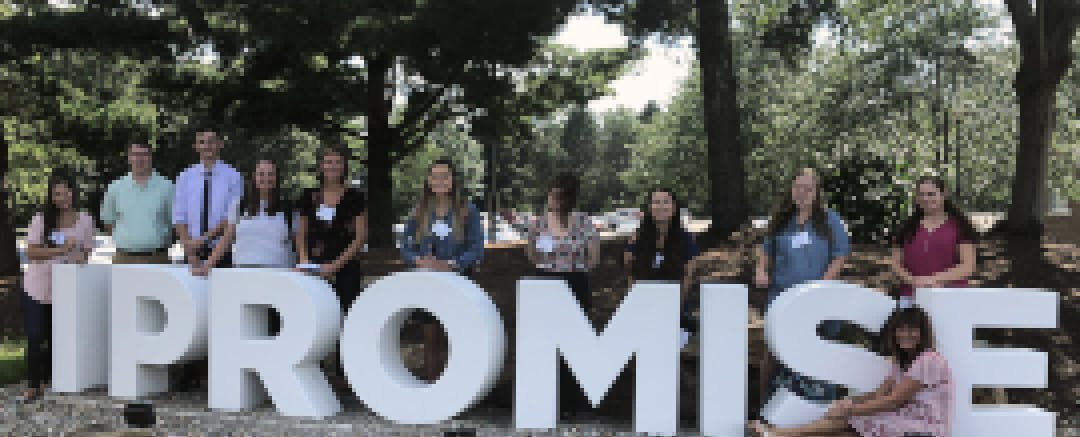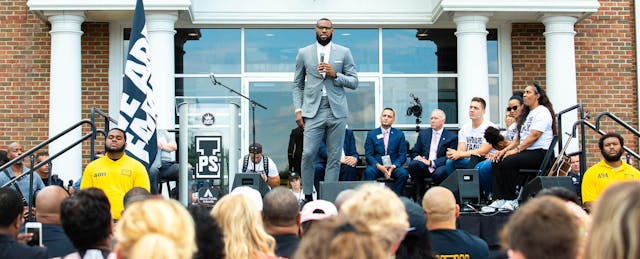Even before students entered the halls of the new I Promise School in Akron, Ohio, the experimental effort had received widespread acclaim for its efforts to get low-performing students on a path to college early. It helped that LeBron James, the NBA superstar and Akron native, started the I Promise program and guaranteed college tuition to the University of Akron for those who participated.
But the I Promise School’s touchpoints with the local public university span far beyond college tuition. And that’s part of the school and James’ long-term vision.
James started the I Promise education program in 2011, providing resources and academic support to help students stay in school. In 2015, that effort expanded to include four-year scholarships for eligible I Promise students to the University of Akron. But barriers to eligibility for that scholarship persisted: Just 76 percent of students in Akron Public Schools’ class of 2017 graduated from high school within four years.
“Simply throwing a scholarship at an adolescent is not necessarily something they have experience with within their families,” says Susan Kushner Benson, associate professor at the LeBron James Family Foundation College of Education at the University of Akron. “We want to create generational change.”
Kushner Benson leads the partnership between the I Promise School and the University of Akron. At the university, she worked for several years to evaluate I Promise after-school programs. So when I Promise expanded to become its own school this summer, she relocated her office on campus a mile west to IPS itself.
“Many of the people I need to work with on program development and evaluation are here at the school, and many of us [from the University of Akron] now have offices here,” says Kushner Benson. “It makes sense for us to all be in a central place.”
IPS is undoubtedly unique. In addition to the tuition guarantee (which is so far funded for 10 years), the school identified 240 third- and fourth-grade students within Akron Public Schools who were significantly behind their peers academically. The students come from a mix of backgrounds: More than half of the student population at IPS is black, 6 percent is Hispanic or Latino, 9 percent is two or more races and 19 percent is white, according to Akron Public Schools.
The school’s wrap-around approach to serving the whole child includes providing breakfast and daily 15-minute social-emotional learning circles for students, who attend school year-round from 9 a.m. to 5 p.m. A resource center at the school also offers courses for parents of students at IPS who are working to earn their high school GED, career planning and ESL classes.
Notably, IPS is not a charter; it is a public school within the Akron Public Schools system. The school currently hosts grades three and four, and plans to add grade levels to reach first through eighth grade by 2022.

In the Field, On Campus
What also sets the school apart is another group of students who are taking classes at IPS: undergraduates at the University of Akron.
A group of 79 undergraduates studying at Akron University’s College of Education are taking courses and completing field experience at IPS. Three college-level courses are being offered at IPS, and each are part of the Early Childhood Inclusive Teacher Preparation Program in the Department of Curricular and Instructional Studies.
The student teachers will help provide instruction to small groups of students as part of three courses: Assessment and Instruction in Literacy; Mathematics in Inclusive Early Childhood Settings; and Integrated Expressive Arts in Early Childhood.
Including university students was part of the IPS blueprint. Michele Campbell, executive director of the LeBron James Family Foundation, says that the school’s location was strategically chosen not only to be close to faculty researchers, but also to make it easy for college students to come to the school, serve as mentors and gain experience working in urban education.
“You can sit in a classroom and learn, but to be in there and infused, to be able to walk upstairs and practice what your are learning—while being a hand for our teachers and mentor to students—it’s a win-win-win all around,” says Campbell.
Along with program development and evaluation, Kushner Benson runs a semester-long mentorship course called Urban Youth Mentoring where undergrads from all majors work with middle school-aged I Promise students.
The course is taught by Akron Public Schools employees, such as guidance counselors, who provide training in mentorship. And the college students aren’t required to help mentees with academics. Some do, says Kushner Benson, but others may focus more on relationship-building, and that could mean simply playing cards and getting to know their mentor.
The mentors also help the middle school students create a collage-like vision board based around what I Promise means to them. This fall, those will be displayed in the I Promise Institute on the University of Akron campus, a previously undeveloped space in the university's football stadium recently renovated into a hub for I Promise students and their families.
Beginning in October, the 7,000-square foot institute will also serve as a place where high school students in the I Promise program can receive literacy tutoring and work with graduate students who are pursuing a Masters in Elementary Education and Literacy.
The institute is part of a long-term plan to keep I Promise students in college once they get there. “If you look at retention statistics from freshman to sophomore yes, it’s scary. We don’t want our students to be a statistic once they get [to the university],” says Campbell. “Having that home away from home there, where they feel connected and safe, that was really important for us.”
Rooted in Research
“Just giving a scholarship, I would be really scared to see how many actually earned it at the end of the day without all these extra supports,” says Campbell. But she admits that the school has a weakness: “We aren’t the most techy,” she says. And as the school prepares to grow, the staff will need some support measuring student progress.
So to track if the school’s services are preparing students to be eligible for a scholarship, should they choose to go to college, the LeBron James Family Foundation teamed up with JP Morgan Chase to create an app that follows how students are doing. So far, it looks at data including students’ GPA, community service hours and attendance.
Because IPS has researchers like Kushner Benson evaluating programs in real-time, things can change quickly. That includes identifying mistakes and where things aren’t going according to plan. Already the school has made adjustments since opening its doors in July, Campbell says. For instance, because the school year started mid-summer and days are eight hours long, they quickly realized that students (and teachers) were pretty tired by the end of the day. They are now working to adjust the programming and classes so the longer day isn’t overwhelming.
Campbell, like many others involved with I Promise, is a University of Akron alum. And she says having researchers like Kushner Benson on campus is crucial to the program’s work. “I need to understand what’s working,” she notes.
When its leaders first started designing the school, however, they took a less-than-scientific approach: “We went to LeBron and Gloria James. We said, ‘you struggled in third, fourth, fifth grades. What would have helped you in those darkest days?” Then they asked I Promise students and their parents the same question. Their answers, says Campbell, “that’s what built this school.”


